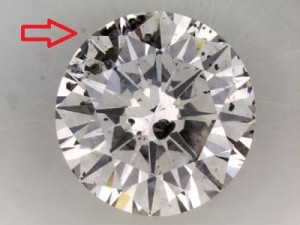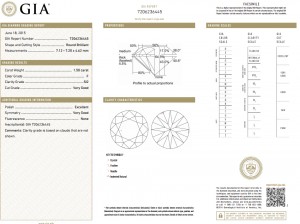Previously on the blog we went over ways to stretch your budget. While there are certainly some excellent ways to maneuver when engagement ring shopping to help you save money while not losing anything visually, there are things that can have drastically negative effects which should be avoided by all means necessary. This week we are going to give you six ways NOT to stretch your budget which will save you lots of time and money. Cutting corners in these instances will not work in your favor
1. DON’T Over-Sacrifice Color: One thing we constantly stress is to not sacrifice too heavily on the color grade of your center diamond. In almost all cases, it is best to stay away from the “Faint Yellow” range with starts with the color ‘K’. Many websites say you can set a faint yellow color diamond into a yellow gold setting and that the center stone will not appear yellow anymore. We find this not to be the case and in fact a yellow setting intensifies the yellow appearance of the diamond. Color is something the human eye can detect very easily. This is not to say that the very top color grade of “D” is a necessity (though beautiful), this is to say not to give up too much because something that appears strong yellow is easy to detect even from away. Clarity and size are harder to tell from a distance however a yellow diamond is incredibly obvious and will detract from the overall beauty of you ring. Staying within the D-J range is usually safe bet but keep in mind this does vary by each shape so keep that in mind
2. DON’T Buy a Heavy Stone: Each diamond will have a unique cut to it. You can have a 1 carat diamond that faces up bigger than its size and you can have diamonds that face up much smaller than their size. For example, I had a customer considering a 2.5 carat cushion cut diamond listed for a very cheap price on an online website. Turns out the 2.5 carat actually only measured 7mm. This is a very very small face up measurements for a 2.5 carat. The high carat weight and extremely low price point can lure you in, but knowing it appears much smaller, means you ultimately have deep cut or bottom heavy diamond. For that same price, you could have gotten a 2 carat with a better cut, higher color and clarity that will look infinitely better. On the flip side be wary of diamonds that are cut too shallow- while they will appear very large face up, it will not have a great sparkle and be susceptible to damage or breaking due to its lack of depth.
3. DON’T Buy a Diamond Completely Sight Unseen: Seeing a price list and accompanying diamond grading report is no way to tell how the diamond actually looks in real life. We buy loose diamonds every day for our inventory, and even as seasoned professionals could never buy one completely sight unseen because there is no way for us to know several key factors such as: which inclusions are most visible? Is it a good “J” color that looks like an “I” or does it have a brown tint? Does the oval have a perfectly rounded outline and no bowtie? Is the stone crisp or hazy due to some inclusions not noted on the certificate? Does the cushion cut have a distinct brilliant faceting pattern or is it watery and dull? These are all questions that will play on your mind if you don’t get a video, or in person look at the diamond. At the end of the day your fiancée is going to be wearing the diamond on their hand and to her eye it has to look gorgeous. A high level purchase like this with such emotional importance needs to have a visual such as an HD video to show you the tiny nuances you can’t see from the listing.
 4. DON’T Place All Your Emphasis on the Inclusion Diagram. GIA certified diamonds come with a certificate and those above 1 carat will have plots showing the location of the imperfections on the diamond. However, this plot does not tell the entire story. You can have a diamond that is graded as SI1 with just twinning wisps, a crystal, and a knot on the certificate and visually the plot will show those lines and dots. You can also have certificate that is filled with clouds making the plot look completely clean because they cannot draw a cloud on the diamond. These diamonds will usually be priced considerably less than others in the same quality family because they will have a hazy, milky appearance and lack the brilliance and sparkle you would expect from a diamond. Also, ones with a crystal in the center could either be a big black inclusion (like the photo shown here) which will not be eye clean or one that is white/transparent and can blend into the stone. The location, color and visibility of the inclusions is nearly impossible to determine solely based on a certificate plot so make sure you are getting real time data to help make your decision more fruitful.
4. DON’T Place All Your Emphasis on the Inclusion Diagram. GIA certified diamonds come with a certificate and those above 1 carat will have plots showing the location of the imperfections on the diamond. However, this plot does not tell the entire story. You can have a diamond that is graded as SI1 with just twinning wisps, a crystal, and a knot on the certificate and visually the plot will show those lines and dots. You can also have certificate that is filled with clouds making the plot look completely clean because they cannot draw a cloud on the diamond. These diamonds will usually be priced considerably less than others in the same quality family because they will have a hazy, milky appearance and lack the brilliance and sparkle you would expect from a diamond. Also, ones with a crystal in the center could either be a big black inclusion (like the photo shown here) which will not be eye clean or one that is white/transparent and can blend into the stone. The location, color and visibility of the inclusions is nearly impossible to determine solely based on a certificate plot so make sure you are getting real time data to help make your decision more fruitful.
5. DON’T Skimp on the Setting: Trying to save money on the setting and assuming another jeweler can successfully copy a design at a lower price is one of the most common mistakes we see. Trying to replicate our finely crafted rings for less money means having to do it with a CAD (computer aided design), lower quality pave diamonds and a general lack of craftsmanship; we guarantee the results will not be the same. We specialize in making these rings and produce hundreds a month in our workshop and have it down to a science. Since we are the originators of our styles we know exactly what size pave stones to use, width of band, height of setting, angles of the curves, etc all of which will impact how the finished piece looks and feels on the hand. You can purchase the most beautiful, high quality center-stone in the world, but the setting is what will make or break the look. Look at all these drastically different ways you can set a diamond with a similar look. The setting does matter! Most of our settings are crafted by hand and it shows in the quality of our work. Featuring seamless halos, baskets that perfectly wrap the diamond, no excess bulky metal you can view a wide array of custom handmade engagement rings from Lauren B right here
6. DON’T Fall Victim to an “Interned Diamond”. Buying a diamond because it is very cheap and looks good on paper will almost always fail to live up to your expectations in real life. This is a lifetime investment and you want to make sure it is something your fiancée will love forever. Diamond prices tend to be very steady and market based, at the carat sizes of 0.5-1 carat-2 carats-3 carats and there is not going to be huge jumps in price if the quality is up to par with what is stat ed on the certificate. From experience, if a diamond is listed hundreds, or even thousands of dollars less than others within the same quality and carat size, the chances are something is very wrong with it that can’t be shown on the certificate. It can come from a poor material that makes it look dull, clouds that make it look milky, bad measurements, uneven sparkle, eye visible inclusions that seem harmless on the certificate plot, strong bow tie, an inferior cut and so on and so forth. The certificate here is one of a diamond you should avoid at all costs- although the price may be attractive, the diamond itself will be lifeless and cloudy. All these factors play a part in pricing and if something is not attractive the seller they will try to get rid of it at a low price to an unknowing consumer who cannot visually inspect the diamond. Those are what we refer to as “Internet Diamonds”
ed on the certificate. From experience, if a diamond is listed hundreds, or even thousands of dollars less than others within the same quality and carat size, the chances are something is very wrong with it that can’t be shown on the certificate. It can come from a poor material that makes it look dull, clouds that make it look milky, bad measurements, uneven sparkle, eye visible inclusions that seem harmless on the certificate plot, strong bow tie, an inferior cut and so on and so forth. The certificate here is one of a diamond you should avoid at all costs- although the price may be attractive, the diamond itself will be lifeless and cloudy. All these factors play a part in pricing and if something is not attractive the seller they will try to get rid of it at a low price to an unknowing consumer who cannot visually inspect the diamond. Those are what we refer to as “Internet Diamonds”
Feel free to contact us to set up a consultation and we can match you with a beautiful diamond engagement ring in your budget to our high quality standards. These tips will not only save you the hassle of diamond shopping, they will also save you from an unhappy fiancée.
You can thank us later 😉
